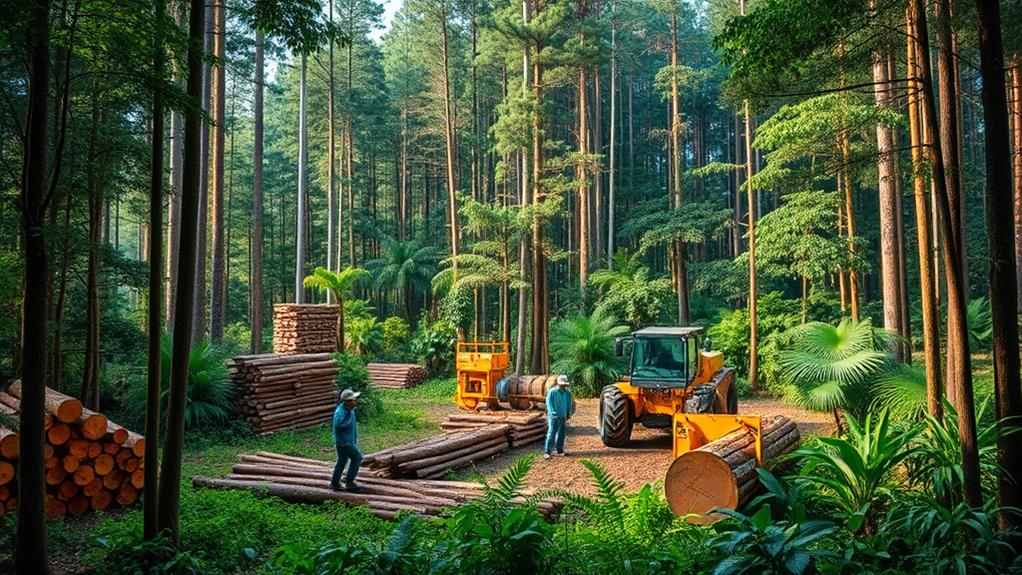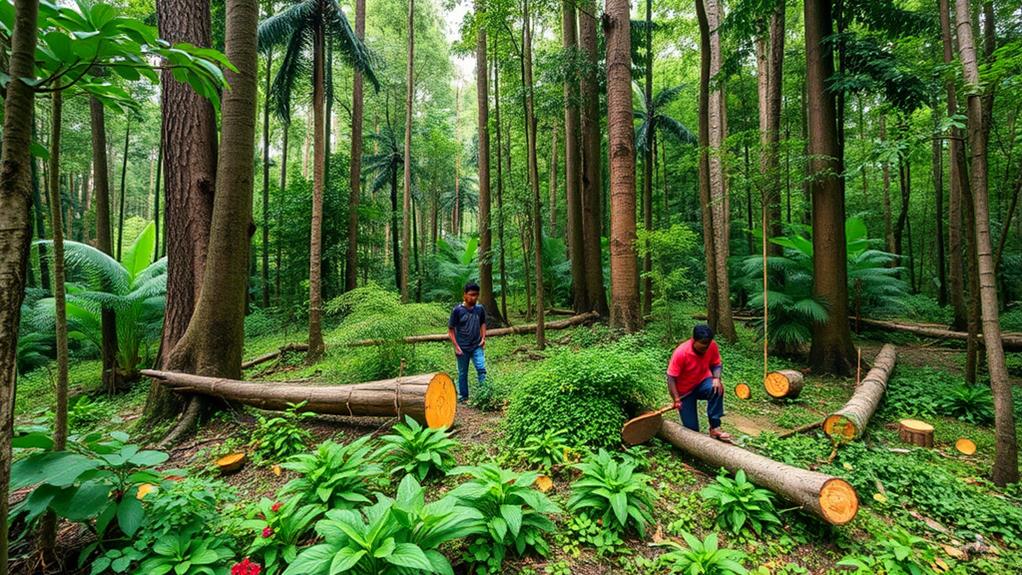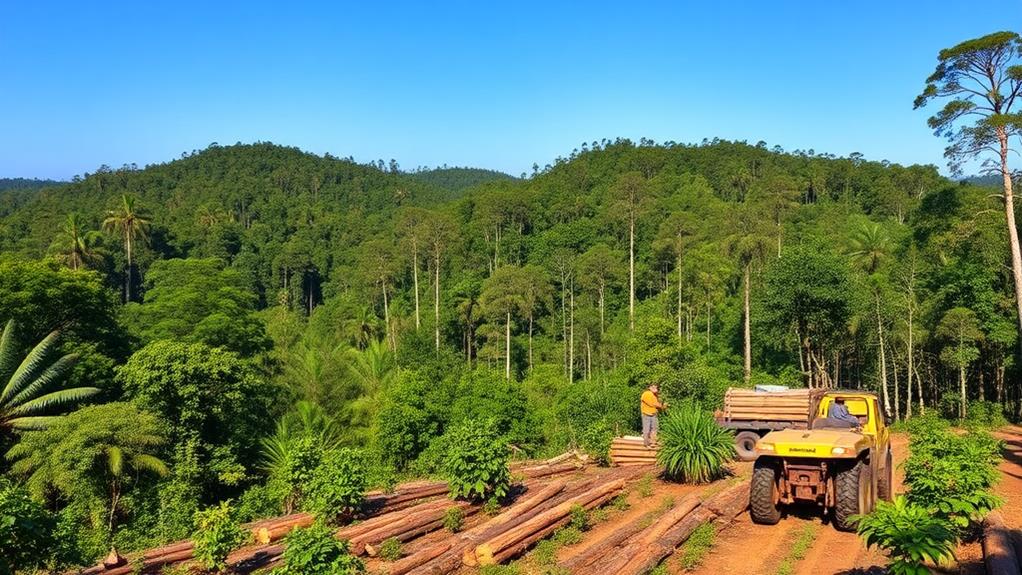The forestry industry in the Philippines is facing serious problems. Timber production is declining, and forest management is poor. As a result, the country has changed from being a net exporter to a net importer of wood products.
Many areas designated as Permanent Forest Estate do not use sustainable practices. This is a problem for the environment and for local communities that depend on forests for their survival.
To combat these issues, current strategies include community-based management and reforestation. These approaches aim to promote sustainable practices.
Understanding these problems is important for addressing environmental degradation and improving forest-related economies. This knowledge can lead to better solutions and help with future developments.
Overview of Forest Resources

In the Philippines, only about 5.4 million hectares of forest area remain as of the year 2000, down from 15.8 million hectares. This significant decline is mainly due to deforestation and poor conservation efforts.
The country has various forest types, including dipterocarp, old growth, secondary, pine, mangrove, mossy, and sub marginal forests. Notably, dipterocarp forests cover approximately 3.54 million hectares.
The Permanent Forest Estate (PFE), which includes natural forests, is around 6.24 million hectares. This includes 4.70 million hectares of production forests and 1.54 million hectares of protection forests.
Since the 1970s, the Philippines has struggled with decreasing timber production, leading to its status as a net importer of wood products. This situation highlights the urgent need for better forest management.
To address these issues, the National Forestation Program aims to create 3 million hectares of plantation forests by 2015. This program is a step toward sustainable conservation and development of forest resources, ensuring the future health of the nation's forests and timber production.
Economic Impact of Forestry
The decline of forest resources in the Philippines has caused serious economic problems, especially in the forestry sector.
Timber production has dropped significantly, leading to a smaller contribution to the national economy. For example, the logging sector's GDP contribution fell from 12.5% in 1970 to only 1.3% in 1990. This decline has affected rural communities, where about 18-20 million people depend on forests for their livelihoods.
Moreover, the industrial forestry sector's GDP contribution decreased to only 0.05% in 2002. This shows how much potential for economic growth has been lost in this area.
However, there's a positive trend in the export value of wood-based manufactured products, which increased from 16% in 1984 to 87% in 1994. This indicates a shift toward value-added products.
To summarize, the data highlights the urgent need for forest conservation and sustainable practices in forestry.
Timber Production Trends

Timber production in the Philippines has declined significantly over the past few decades. This decline is due to several important factors affecting the forestry sector.
The forested area has decreased from 14 million hectares in 1955 to just 5.79 million hectares by 1993. This loss of forest land has impacted timber availability. By the year 2000, only 86 sawmills were operating, and wood shortages meant that only 45 of them were actively producing timber.
There has been a shift in management practices from large commercial timber concessions to community-based management. This change reflects a move towards more sustainable forestry practices. By 2002, the industrial forest sector contributed only 0.05% to the national GDP, showing that the economy has become less dependent on timber.
Currently, approximately 76,000 hectares of the Permanent Forest Estate are being sustainably managed, indicating ongoing challenges in maintaining timber production levels. The phase-out of Timber License Agreements (TLAs) is part of the effort to promote sustainable management practices.
Forest Management Strategies
Forest management strategies are vital due to the decline in timber production in the Philippines. The Philippine Strategy for Sustainable Development provides a framework for managing forests sustainably. It focuses on sustainable management, ecological conservation, and equitable access to forest resources.
The Master Plan for Forestry Development aims to balance environmental protection with economic needs.
A major initiative is the Community-Based Forest Management (CBFM) Strategy. This strategy encourages local communities to participate in decision-making. By doing so, it helps communities manage their forest resources sustainably.
Furthermore, the National Forestation Program plans to create 3 million hectares of plantation forests. This program targets afforestation and reforestation in degraded areas, which will boost timber production and restore ecological balance.
To track the success of these strategies, the Forest Management Bureau (DENR) gathers and shares forestry statistics. They compile this information in the Philippine Forestry Statistics Yearbook.
Regular evaluations help ensure that forest management strategies stay effective. This supports both ecological conservation and sustainable timber production in the Philippines.
Community-Based Forestry Initiatives

Community-based forestry initiatives are important for about 18-20 million Filipinos who rely on forest lands for their livelihoods. These initiatives focus on community forestry and encourage local involvement in managing forest resources.
Empowerment is a key aspect. Local communities take control of their forest lands, allowing them to make decisions about how to use resources.
Sustainability is also a goal. These initiatives work to restore degraded landscapes through reforestation projects, which help bring back healthy forests.
Equity is promoted by the Community-Based Forest Management Strategy, which ensures that all community members have equal access to resources like timber and non-timber forest products.
Investment from the private sector has led to the creation of industrial forest plantations, which help support local economies by providing jobs and products.
However, there are still challenges. While these initiatives show promise, finding ways to increase rural incomes remains a difficult task.
Data Collection and Reporting
Effective data collection and reporting are essential for managing the forestry industry in the Philippines. The Forest Management Bureau (DENR) is responsible for gathering forestry statistics through the Philippine Forestry Statistics Yearbook. Data is collected from regional offices and organized into four levels, which helps in consolidating information systematically.
The Central Office then processes this data to provide an overview of timber production and forest management.
The Statistical Reporting System (SRS) improves the accuracy of environmental statistics. It uses validation methods like cross-checking reports from licensees to ensure information is correct. Additionally, the Revised Price Monitoring System (RPMS) collects monthly price data on forest products, which helps in setting charges as per Republic Act 7161.
The Philippine Forestry Statistics Yearbook is the official source for this important information. It's available through fax, e-mail, and the Internet, making it accessible for all stakeholders involved in forestry management.
This organized approach to data collection is vital for promoting sustainable forestry practices in the country.
Environmental Challenges

Deforestation in the Philippines is a serious problem that affects both nature and people's lives.
Forest areas have decreased from 14 million hectares in 1955 to only 5.79 million hectares by 1993. This rapid loss of trees leads to soil erosion and water problems, causing an annual economic loss of P6.7 billion.
One major reason for deforestation is illegal logging and land conversion for agriculture. These practices harm forests and reduce biodiversity, which means fewer plants and animals can survive.
For example, only 21% of the remaining dipterocarp forests are still classified as primary, meaning they're untouched by human activities.
The loss of trees also causes soil erosion, which makes it harder for farmers to grow crops and can lead to poorer water quality.
As of now, only about 76,000 hectares of the Permanent Forest Estate are managed sustainably. This shows that achieving sustainable practices in forestry is very challenging.
Addressing these issues is essential for protecting forests and supporting the communities that rely on them.
How Does Forest Management Play a Role in Ensuring Sustainability in the Philippine Sugarcane Industry?
Forest management plays a crucial role in ensuring philippine sugarcane production sustainability. Proper management prevents deforestation and soil erosion, which can have a significant impact on the sugarcane industry. Sustainable forestry practices contribute to maintaining a healthy ecosystem and supporting the long-term success of the sugarcane industry in the Philippines.
Revenue Trends in Timber Industry
The timber industry in the Philippines is facing serious challenges due to environmental issues. Timber production has significantly decreased over the past 30 years. For example, the industry's contribution to the country's GDP fell from 12.5% in 1970 to only 0.05% by 2002. This decline shows how tough things have become for the industry.
In 2000, there were only 86 sawmills operating, but due to wood shortages, only 45 were actually producing timber. This limited production makes it hard for the industry to earn enough money. Additionally, the lack of sustainable land management practices is causing the area available for timber production to shrink.
The industry has also changed from being a net exporter to a net importer of wood products. This shift highlights the difficulties in adjusting to changing market conditions.
From 2012 to 2024, revenue figures have varied greatly, often due to past data errors. These factors combined create a difficult situation for the financial health of the timber industry, showing the need for better management and planning to improve current trends.
Future of Forestry in the Philippines

The future of forestry in the Philippines depends on new strategies that address environmental and economic issues. Key areas to focus on include:
- Expanding the National Forestation Program to plant 3 million hectares of trees. This helps restore forest cover and improves air quality.
- Encouraging community-based forest management. This empowers local communities to take care of their forests, leading to better conservation and economic benefits for them.
- Using longer harvest cycles. This means waiting longer before cutting down trees, which can lead to healthier forests and more timber over time.
- Strengthening property rights enforcement. This helps protect forests from illegal cutting and supports sustainable practices.
- Investing in local manufacturing plants. This encourages the use of local timber in products, which can support the economy and reduce waste.
The Philippines has only 76,000 hectares of natural forest that are sustainably managed. It's urgent to improve forest management practices.
A community-focused approach can reduce reliance on imported timber and support local jobs. By focusing on land management and community involvement, the forestry sector can thrive and ensure that forests are preserved for future generations.
Questions and Answers
What Is the Forestry Industry in the Philippines?
The forestry industry in the Philippines focuses on sustainable practices. This means that forests are managed in a way that protects the environment while still allowing for the use of timber. One important aspect is combating illegal logging, which harms forests and wildlife. The government has created laws to stop this activity and protect natural resources.
Another key effort in the industry is reforestation. This involves planting new trees to replace those that have been cut down. For example, programs have been established to plant native tree species in various regions to restore habitats.
Additionally, community involvement is crucial. Local communities are encouraged to participate in forest management. This includes educating them about the importance of forests and how to protect them. By working together, communities can help ensure that forests remain healthy and sustainable.
Lastly, protecting indigenous rights is also a priority. Indigenous people play a vital role in forest conservation. Laws are in place to safeguard their land and ensure they have a say in how forests are used. This helps balance the need for timber exports while minimizing environmental impact.
What Is the Forest Management Program in the Philippines?
The forest management program in the Philippines focuses on sustainable practices. This means using resources in a way that does not harm the environment. For example, it includes reforestation efforts where new trees are planted to replace those that were cut down.
The program also involves community involvement, encouraging local people to participate in protecting forests. To fight against illegal logging, strict policy frameworks are enforced. This helps to ensure that trees are only cut down legally and responsibly.
Additionally, the program promotes timber certification. This means that wood products come from forests that are managed sustainably. Finally, it enhances forest monitoring for biodiversity conservation. This ensures that different species of plants and animals are protected and can thrive in their natural habitats.
What Are the Problems With the Wood Industry in the Philippines?
Illegal logging harms government efforts in the Philippines. It leads to biodiversity loss, meaning fewer plants and animals survive. For example, cutting down trees without permission destroys habitats. Economic impacts also arise, as illegal logging can reduce income from legal timber sales.
Reforestation and sustainable practices aim to improve the situation. These methods include planting new trees and using wood responsibly. However, community involvement is essential. When local people participate, they can help protect forests and support legal timber trade, making efforts more effective.
What Is the Current Status of the Forest in the Philippines?
Deforestation in the Philippines is a serious issue. Current deforestation rates are alarming, leading to a loss of many plant and animal species. For example, many forests are being cut down for logging and agriculture, which harms the environment.
To combat this, reforestation efforts are essential. This means planting new trees in areas where forests have been destroyed. Additionally, conservation strategies help protect existing forests. However, illegal logging remains a significant threat to these efforts, making it harder to restore and preserve forests.
Upholding indigenous rights is also important. Indigenous communities often have a deep connection to the land and can help protect it. By respecting their rights and knowledge, we can promote sustainable practices that benefit both the environment and local communities. Overall, these actions can help reduce climate change impact and keep vital ecosystems safe.